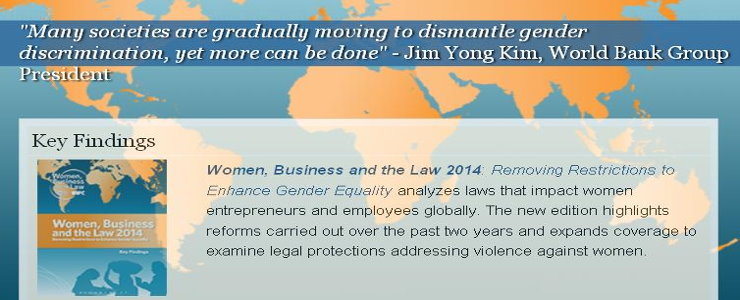
2013.10.02
Women, Business and the Law 2014 : Removing Restrictions to Enhance Gender Equality

Women, Business and the Law 2014: Removing Restrictions To Enhance Gender Equality finds that while 42 economies reduced legal differences between women and men, 128 out of 143 economies studied still impose legal differences on the basis of gender in at least one of the report’s key indicators. The report also identifies 48 law and regulatory reforms enacted between March 2011 and April 2013 that could enhance women’s economic opportunities.
In all economies, married women face more legal differentiations than unmarried women. In 25 economies, married women cannot legally choose where to live in the same way as married men, and in 29 they cannot be legally recognized as head of household in the same way as married men. The 2014 report covers new questions on issues such as gender differences in obtaining national identification cards; the use of quotas to increase women’s representation on corporate boards, national parliaments and local governments; women’s ownership rights in the marital home; and the number of women justices in supreme courts. The report also includes a new indicator, Protecting women from violence, which examines laws on domestic violence against women and the existence and scope of laws on sexual harassment.
The report finds that economies with greater numbers of restrictions on women’s work have, on average, lower female participation in the formal labor force and have fewer firms with female participation in ownership. Conversely, economies which provide a greater measure of incentives for women to work, have greater income equality.
Every region includes economies with unequal rules for men and women, although the extent of the inequality varies widely. On average, high-income economies have fewer differences than middle- and low-income economies. The Middle East and North Africa have the most legal differences between men and women, followed by South Asia and Africa. In Africa, a notable exception is Cote d’Ivoire, which leads globally with the most gender-parity reforms during the past two years. Ivorian wives can now choose the family residence and claim tax deductions for their children or spouses in the same manner as their husbands as the result of sweeping 2013 reforms. Further, each spouse can now stop the other from working if they deem it against family interests, whereas prior to the 2013 reform only husbands had this ability under the law. Regionally, the most improvements in gender parity occurred in Sub-Saharan Africa.
Using the newly released historical data captured in the 50 Years of Women’s Legal Rights Database, the report also highlights how restrictions on women’s legal rights have changed over time in two of the Women, Business and the Law Indicators (Accessing institutions and Using property) across 100 economies. More than half of the restrictions on women’s legal rights in place in 1960 have since been eliminated. While most economies have made great strides towards gender parity by decreasing legal restrictions on women, the Middle East and North Africa has made the least reforms since 1960.
Source: the World Bank


